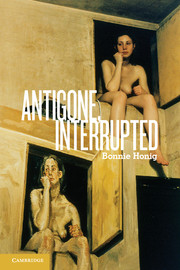Book contents
- Frontmatter
- Contents
- Preface
- Acknowledgments
- Introduction
- Part I Interruption
- Part II Conspiracy
- 4 Mourning, membership, and the politics of exception: plotting Creon's conspiracy with democracy
- 5 From lamentation to logos: Antigone’s conspiracy with language
- 6 Sacrifice, sorority, integrity: Antigone's conspiracy with Ismene
- Conclusion
- About the Cover Image
- Notes
- Bibliography
- Index
5 - From lamentation to logos: Antigone’s conspiracy with language
Published online by Cambridge University Press: 05 May 2013
- Frontmatter
- Contents
- Preface
- Acknowledgments
- Introduction
- Part I Interruption
- Part II Conspiracy
- 4 Mourning, membership, and the politics of exception: plotting Creon's conspiracy with democracy
- 5 From lamentation to logos: Antigone’s conspiracy with language
- 6 Sacrifice, sorority, integrity: Antigone's conspiracy with Ismene
- Conclusion
- About the Cover Image
- Notes
- Bibliography
- Index
Summary
A tribe has two concepts, akin to our “pain.” One is applied where there is visible damage and is linked with tending, pity, etc. The other is used for stomach-ache for example, and is tied up with mockery of anyone who complains.
WittgensteinIn order to qualify as illegal torture, physical pain “must be equivalent in intensity to the pain accompanying serious physical injury such as organ failure, impairment of bodily function, or even death,” – a legal memo authorizing abuse [and torture] of prisoners approved by George W. Bush, primarily authored by John Yoo.
Andrew SullivanAnd she cried out a sharp, piercing cry . . .
Sophocles, AntigoneSo the simple opposition between logical animals and phonic animals is in no way the given on which politics is then based . . . The logos is . . . the account by which a sonorous emission is understood as speech, capable of enunciating what is just, whereas some other emission is merely perceived as a noise signaling pleasure or pain, consent or revolt.
Jacques RancièreThe regulation of laments in fifth-century Athens is one context in relation to which we can usefully read Sophocles’ Antigone, but there are others. If Chapter 4 proposed a new reading of Antigone in historical context, here in Chapter 5 history intrudes (as Carl Schmitt might say) on Sophocles’ text, and the result is a strange torsion that opens other new and surprising dimensions of the play, amplifying its overlife and not just, as contextualists might assume, its original life in context.
- Type
- Chapter
- Information
- Antigone, Interrupted , pp. 121 - 150Publisher: Cambridge University PressPrint publication year: 2013

